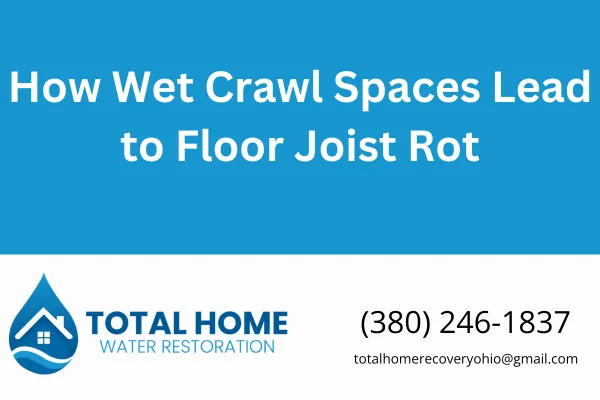
How Wet Crawl Spaces Lead to Floor Joist Rot
How Wet Crawl Spaces Lead to Floor Joist Rot
If your crawl space is wet, your floor joists are in danger—plain and simple. At Total Home Water Restoration, we’ve seen how hidden moisture beneath a home can quietly turn solid lumber into soft, rotting wood. If you’re in Grove City, Columbus, or nearby towns and notice soft spots in your floor or a musty smell, it might be time to look below.
The Real Problem: Constant Moisture
Crawl spaces naturally sit in the lowest part of your home. When water from heavy rains, high humidity, or even small plumbing leaks finds its way in, it often stays trapped. Most crawl spaces aren’t built to dry out on their own, especially if:
There’s no vapor barrier
The soil is exposed
The space is poorly ventilated
HVAC ducts or pipes are leaking condensation
This damp, stagnant environment becomes the perfect breeding ground for wood rot fungi.
Why Floor Joists Start to Rot
Wood rot happens when three things come together: moisture, warmth, and wood. Floor joists, being the horizontal beams under your subfloor, are often made from untreated wood. When these stay damp for extended periods—over 20% moisture content—they start to decay.
We’ve pulled back insulation in many Grove City crawl spaces only to find:
Joists so soft they can be poked with a screwdriver
Mold covering the underside of the subfloor
Sagging floors from weakened wood
In some cases, we’ve had to jack up the floor and replace entire sections of framing. It’s not a cheap fix—but it’s a necessary one.
Code Insight
According to IRC Section R317.1, untreated wood in contact with the ground or exposed to moisture must be naturally durable or pressure-treated. Unfortunately, many older homes weren’t built to these specs. That’s why proactive crawl space maintenance matters.
What You Can Do
Here’s how to protect your floor joists from rot:
Install a vapor barrier: A 6-mil plastic sheeting sealed over the ground cuts off moisture.
Control humidity: Use a crawl space dehumidifier or condition the space with your HVAC system.
Seal air leaks: Close gaps around pipes and vents to reduce humid air infiltration.
Redirect water: Make sure gutters, downspouts, and grading push water away from your foundation.
Inspect regularly: Look for damp insulation, water stains, or musty smells.
When to Call Us
If you suspect your crawl space might be damp—or you’ve already seen signs of damage—don’t wait. We’ll inspect the space, test wood moisture levels, and give you real answers.
Call Total Home Water Restoration at 380-246-1837. We’re based right here in Grove City and serve all of Columbus, Hilliard, Westerville, Reynoldsburg, and nearby areas.
We fix it like it’s our own home.
